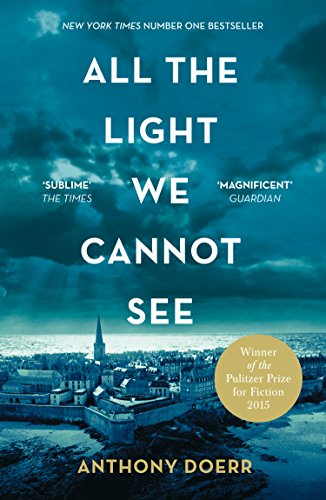All the Light We Cannot See Summary
11 min read ⌚
 Ready for a tearjerker you can read while riding the subway?
Ready for a tearjerker you can read while riding the subway?
How about a Pulitzer Prize-winning novel?
Believe it or not, we’re talking about one book:
Anthony Doerr’s All the Light We Cannot See.
Who Should Read “All the Light We Cannot See”? And Why?
If you are interested in the Second World War, here’s one book which covers the more personal aspects of it, both from the perspective of a French girl and a German boy.
Also, if you want a profoundly tender story which talks about the things which connect us even in the time of war in beautiful, symbolic language – then look no further.
Anthony Doerr Biography
Anthony Doerr is an American author, writer of two novels, two short story collections and a memoir.
is an American author, writer of two novels, two short story collections and a memoir.
He debuted with The Shell Collector, a collection of short stories set mostly in Africa and New Zealand. Both his first novel, About Grace, and his memoir, Four Seasons in Rome, were well received, but neither brought him nationwide acclaim.
Doerr’s second short story collection, Memory Wall, won him a few prizes, but it was his second novel, All the Light We Cannot See, which brought him to the fore as a major writer, receiving both critical and popular acclaim.
Plot
When Anthony Doerr was writing All the Light We Cannot See, he was consciously writing a book for the 21st century!
Knowing full well that, in this day and age, nobody has the time and energy to read long fiction works such as War and Peace or Anna Karenina – or even half-fiction such as The Gulag Archipelago – he opted to write All the Light We Cannot See in hundreds and hundreds of concise chapters.
You know, the ones you can read on your break or while riding the subway; we guarantee you that that’s where you’ll read most of All the Light We Cannot See if you decide to.
However, the fact that you’ll always yearn for at least one more chapter doesn’t mean that this is a straightforward story.
For one, it’s not told in a chronological manner, with the chapters continually jumping back and forth across time. It’s also told through two different perspectives which makes the reading even more complicated. But, also – even more entertaining as well. In fact, it’s fascinating to think that Doerr managed to write such a readable and unputdownable book when you take into account its narrative intricacies and experimental subtleties!
So, bravo, Doerr!
And we apologize sincerely for simplifying your great novel for the purpose of this summary.; but, unfortunately, that’s the only way one can write a 2000-word summary of a book such as this; and we do it out of respect and admiration.
So, let’s go!
1934–1940: Marie-Laure’s Childhood Before the War
In 1934, Marie-Laure LeBlanc, one of the two main characters of this novel, is the 6-year-old daughter of Daniel LeBlanc, a locksmith at the Museum of Natural History in Paris.
She has a great childhood and an even better relationship with her father. However, she starts losing her eyesight and goes blind before her seventh birthday.
Daniel adapts to this and starts teaching Marie-Laure Braille and buying her beautiful books such as Jules Verne’s adventure novels Around the World in Eighty Days and Twenty Thousand Leagues Under the Sea. He also makes her – for each of her subsequent birthdays – small wooden puzzle-boxes which require a sequence of actions to be opened and which hide a small gift inside.
Marie-Laure likes them very much and becomes especially adept at solving them. She also becomes adept at finding her way around Paris without even leaving her room. And that’s because Daniel makes for her detailed wooden models of the city so that she can memorize Paris by touch. Of course, when he is not working, he also spends hours teaching her to navigate herself around the actual city.
And when he is working at the Museum, Daniel is the guardian of a mystical blue diamond with red flames at its center. As Marie-Laure learns during one visit of her father at the Museum, this diamond – called the “Sea of Flames” – is rumored to be cursed:
The curse was this: the keeper of the stone would live forever, but so long as he kept it, misfortunes would fall on all those he loved one after another in unending rain[…] But if the keeper threw the diamond into the sea, thereby delivering it to its rightful recipient, the goddess would lift the curse.
1934–1940: Werner’s Childhood Before the War
Meanwhile, in Germany, Werner Pfennig is an 8-year-old boy (two years older than Marie-Laure) who lives at an orphanage with his sister Jutta in the coal-mining town of Zollverein.
Most of the grown-ups here work in the mines, so you can’t blame Werner for fearing that he will end up there too as soon as he turns fifteen.
Even though he obviously deserves much more: not only he knows how to speak French (taught by the head of the orphanage, Frau Elena), but he is also particularly interested in the sciences.
One day, he and his sister Jutta find a broken short-wave radio behind the orphanage. Somehow, Werner manages to repair it and tune in to a nearby broadcast. These are the first words – symbolically powerful – he hears:
Open your eyes, concludes the man, and see what you can with them before they close forever, and then a piano comes on, playing a lonely song that sounds to Werner like a golden boat traveling a dark river, a progression of harmonies that transfigures Zollverein: the houses turned to mist, the mines filled in, the smokestacks fallen, an ancient sea spilling through the streets, and the air streaming with possibility.
It’s a regular broadcast from France on science and all related matters, aimed at younger listeners. So, it’s like Werner stumbled upon a hidden treasure!
He uses his knowledge to repair the radio of a certain Herr Siedler, a powerful Party official, who expresses his gratitude by recommending Werner to the National Institute, a prestigious Nazi school. Needless to say, Werner passes his exams.
Finally, he can let off some steam: he can now be sure that he will not work in the mines.
1940: The Invasion of France: Marie-Laure in Saint-Malo
But then, at the end of 1939, the war erupts.
Just a year later, the Germans invade Paris, and Daniel and Marie-Laure have no option but to flee from Paris. They go to Saint-Malo where Marie-Laure’s great-uncle Etienne LeBlanc lives.
Daniel has another reason to flee.
Unbeknownst to Marie-Laure, he is tasked with guarding the Sea of Flames diamond. Or, at least one of the three exact copies of it, made as a diversion.
All of them have been handed to four different guardians, none of which knows whether he as the original in his possession. So, even though three of the gems are worthless fakes, all four protectors are sent to different parts of France and advised to keep them with their lives.
Daniel hides his Sea of Flames in a small wooden “puzzle-box” replica of the house they’re living in which fits perfectly in the model of Saint-Malo placed at the foot of Marie-Laure’s bed so that she can learn this town by touch as well.
In time she does. But by that time, she spends all of her time at home. The good part: this means that Marie-Laure gets to know her great-uncle better, for he doesn’t leave the house as well.
And she learns that even though a reclusive and an eccentric (probably because of a PTSD from World War I), Etienne is also a very likable man who knows a lot about science.
And get this!
His deceased brother Henri – i.e., Marie-Laure’s grandfather – knew just as much. And the two used to broadcast science shows from a secret radio room in the attic of the house.
Yup: that’s who Werner learned his science stuff from!
1940–1944: Werner at the National Institute
Speak of the devil.
Werner is acing his classes at the National Institute, which, of course, means that he’s slowly but surely turning into a Nazi. However, there’s always something more in him, something which resists a total transformation:
Werner is succeeding. He is being loyal. He is being what everybody agrees is good. And yet every time he wakes and buttons his tunic, he feels he is betraying something.
In fact, it is this feeling of “betraying something” which will get Werner expelled from the National Institute.
At first, his capabilities win him the favor of his physics professor Dr. Hauptmann with whom he spends a lot of time designing a radar system. However, when his friend Frederick refuses to torture a prisoner and is savagely beaten for this, Werner (who, by the way, agrees) asks Dr. Hauptmann to leave the school to deal with the trauma.
OK, says Hauptmann, you can leave it.
By going to the army, that is.
1940–1944:The French Resistance
One day, Daniel LeBlanc informs Marie-Laure that he needs to leave immediately but will be back soon. Months pass, and this doesn’t happen; it’s become evident that Daniel has been arrested by the Germans who had noticed him measuring distances and drawing buildings in Saint-Malo.
You’ve read our summary pretty carefully, and you know the reason why he would do such a thing; but the Nazis haven’t, and they suppose that he’s a spy.
In Daniel’s absence, Marie-Laure grows even closer with Etienne and longtime housekeeper Madame Manec.
And Madame Manec is not an ordinary maid: she, along with other local elderly women, does whatever she can to undermine the Nazis in a myriad of small ways. Unfortunately, after some time, she grows ill and dies.
It’s time for Etienne and Marie-Laure to do something in her honor.
And they do!
Marie-Laure goes to the bakery store every day and collects notes from the Underground hidden in the loaves of bread, which afterward Etienne broadcasts from the restarted radio.
In the meantime, Marie-Laure receives a key to a secret hiding place (a grotto in the city wall, at the skirts of the sea) from an old man named Harold Bazin.
1944: Everybody’s in Saint-Malo
In the army, Werner continues doing what he does best: using his radio skills to track down enemy broadcasters (mostly in Russia). However, since his discoveries lead directly to the murders of the secret broadcasters – and, in one case, an innocent little girl – he’s starting to feel less and less at ease with his job.
At the same time, he’s haunted by memories of his childhood, when radio broadcasting seemed to him a way of bridging the gap between people (he was learning about the world in French) and when science was all about the wonder and the beauty of this world; and not about its ugliness and death.
By chance, at around this time Werner – together with a large soldier named Frank Volkheimer – is ordered to find and destroy a secret radio station broadcasting Resistance messages from Saint-Malo.
He traces the network to Etienne’s house; and then he realizes that it’s the same radio station from where the beloved broadcasts of his childhood had been emitted.
After a second of hesitation, he decides to leave the broadcast to continue.
Meanwhile, Saint-Malo is visited by another colorful figure: a Nazi gemologist and official by the name of Sergeant Major Reinhold von Rumpel.
His job?
To track down the Sea of Flames diamond.
He has already found the other three gems and realized that they were fakes; now, he’s in Saint-Malo to acquire the last one, the actual jewel.
And he has an even stronger reason to do it, in addition to this being his official task.
Namely, though he doesn’t fully believe the story behind the diamond, he is struggling with a malignant tumor; so, at least he wishes to be true: he’s secretly hoping that the Sea of Flames may save his life.
August 7, 1944: The Allied Bombing of Saint-Malo
Few days before August 7, 1944, American airplanes drop pamphlets informing the French citizens of Saint-Malo to leave the town.
Since, by this time, Etienne has been sent to jail for being a resistance fighter, Marie-Laure is alone in the house, and the message doesn’t reach her.
She is in the house when the Allied forces begin the bombing of Saint-Malo.
Werner is also there, hiding with Frank Volkheimer in a cellar beneath a hotel. From there, he is able to listen to the radio program from Marie-Laure’s house.
And there’s still such a thing, since Marie-Laure makes her own broadcasts, reading pages from her favorite book, Twenty Thousand Leagues Under the Sea.
However, von Rumpel has discovered Marie-Laure’s hiding-place in the meantime and believes that she must know where the diamond could be. In fact, it is his suspicion that leads Marie-Laure to a revelation: she discovers the diamond in the puzzle-box replica of Etienne’s house in the model-city of Saint-Malo!
Von Rumpel searches through the house in vain – he finds neither the diamond nor Marie-Laure. Afraid that he’s after her, Marie-Laure says during the radio broadcast that a man in her house is trying to kill her.
This animates Werner who uses a bomb to find a way out of the cellar. He rushes to the house of Marie-Laure where he arrives at the very last moment. He manages to kill von Rumpel and introduces himself to Marie-Laure, only to realize that she is blind.
Werner leads Marie-Laure to safety and, even though he spends just a brief time with her, he feels a strong and profound connection with her.
Marie-Laure feels the same, so she decides to tell Werner everything about the Sea of Flames, giving him the key to Harold Bazin’s grotto, where she eventually hides the diamond.
All the Light We Cannot See Epilogue
Marie-Laure and Werner spend some time together, and Werner manages to send Marie-Laure away into safety. However, very soon, he is arrested by American soldiers and sent to a disarmament center where he becomes ill. In a feverish delirium, he Inadvertently steps on a landmine and is instantly killed.
Marie-Laure, meanwhile, is reunited with the freed Etienne, with whom she moves back to Paris; they remain very close for the next decade, at the end of which Etienne peacefully dies.
Many years later – sometime around 1975 – Werner’s sister Jutta (now married with a boy named Max) receives a model house from Frank Volkheimer, Werner’s war buddy.
Jutta finds in it a key and information which leads her to France and Marie-Laure, now a respected specialist in mollusks and whelks with a daughter.
It seems that the last thing Werner had with him before he died was the gift from Marie-Laure.
The story fasts forward to 2014, and the 86-year-old Marie-Laure. Walking down the streets of Paris with her grandson Michel, she wonders about all the important people in her life who have now become spirits: Manec, Etienne, and, above all, her father.
Like this summary? We’d like to invite you to download our free 12 min app for more amazing summaries and audiobooks.
“All the Light We Cannot See Summary Quotes”
Don’t you want to be alive before you die? Share on X Time is a slippery thing: lose hold of it once, and its string might sail out of your hands forever. Share on X All your life you wait, and then it finally comes, and are you ready? Share on X We rise again in the grass. In the flowers. In songs. Share on X You know the greatest lesson of history? It's that history is whatever the victors say it is. That's the lesson. Whoever wins, that's who decides the history. Share on XOur Critical Review
All the Light We Cannot See won both the 2015 Andrew Carnegie Medal for Excellence in Fiction and the 2015 Pulitzer Prize for Fiction.
For a reason: it’s an exquisitely written and captivating novel, an emotionally charged read which is bound to bring tears on your face quite a few times.
And not many novels lauded by modern critics can do that, can’t they?
Emir is the Head of Marketing at 12min. In his spare time, he loves to meditate and play soccer.







